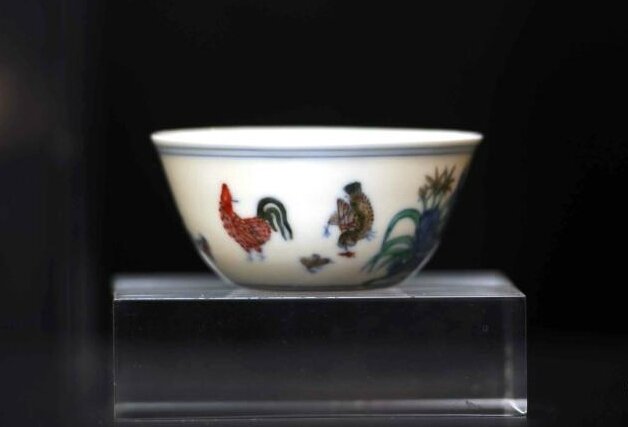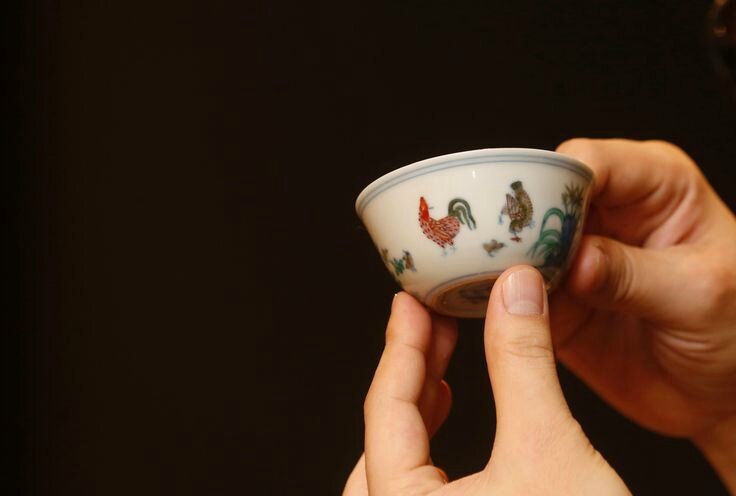Sotheby's Hong Kong to sell The Meiyintang Chenghua "Chicken Cup" on 8 April
Chicken Cups” are the most expensive, most sought-after and most reproduced Chinese objects ever since the Ming dynasty. Est. HK$200 – 300 million / US$25.6 – 38.5 million. Photo: Sotheby's.
HONG KONG.- Sotheby’s Hong Kong will present the Meiyintang Chenghua “Chicken Cup” (Est. HK$200 – 300 million / US$25.6 – 38.5 million*) at its Fine Chinese Ceramics and Works of Art Spring Sales to take place on 8 April at the Hong Kong Convention and Exhibition Centre. First created in the Chenghua reign (1465 – 87), “Chicken cups” have been praised, desired and reproduced by Ming (1368-1644) and Qing (1644-1911) emperors and other discerning literati collectors. With a legendary aura that goes well beyond their immediate arthistorical importance, “chicken cups” have in modern days set record prices for Chinese art in 1980 and 1999^. The particular specimen offered, one of only four preserved in private hands, comes from the celebrated Meiyintang Collection, Europe’s grandest collection of Imperial Chinese porcelain, and has the most illustrious provenance spanning the revered collections of Mrs. Leopold Dreyfus, Sakamoto Goro, Giuseppe Eskenazi and, reputedly, Edward T. Chow.
Nicolas Chow, Deputy Chairman of Sotheby’s Asia and International Head of Fine Chinese Ceramics and Works of Art, said, “It is a great privilege for us to offer this iconic ‘chicken cup’ again at auction, 15 years after it broke a world record for Chinese art back in 1999. Ever since the Ming dynasty when they were produced, Chenghua period ‘chicken cups’ have been praised and treasured by emperors and connoisseurs alike. Given their extreme rarity, they are by definition the crowning glory of any collection of Chinese porcelain.”
The Meiyintang Chenghua Chicken Cup (Diameter 8.2cm) – A Panorama. Photo: Sotheby's.
Created in the Chenghua reign (1465-87), when quality was at its peak, “chicken cups” are outstanding in their tactile material, their range of colours, and their charming, unmannered painting style. First seen on porcelain in the Chenghua period, the subject matter of a cock and a hen with chicks in a garden was a well-known topic of Song dynasty (960-1279) painting and the Chenghua Emperor inscribed a poetic colophon about the subject on a Song hanging scroll of a hen and chicks.
Praised and desired by Ming (1368-1644) and Qing (1644-1911) emperors and other discerning literati collectors, “chicken cups” have over the centuries acquired a legendary aura as a testimony to Chinese ceramic connoisseurship, that goes well beyond their immediate art-historical importance. The Wanli Emperor (r. 1572-1620) is known to have admired Chenghua “chicken cups” in particular, which made them expensive already at that time. Many copies of doucai “chicken cups” including Imperial ones were made in the early Qing dynasty, varying considerably in the details of the decoration. During the Kangxi period (1662-1722) their value rose even further and is said to have surpassed that of the celebrated Song wares. The Qianlong Emperor (r. 1736-95) wrote an ode in praise of “chicken cups”. To own a Chenghua doucai cup at that time had become synonymous with enjoying a small fortune.
Chicken Cups” are the most expensive, most sought-after and most reproduced Chinese objects ever since the Ming dynasty. Est. HK$200 – 300 million / US$25.6 – 38.5 million. Photo: Sotheby's.
A Rare Occurrence
Chenghua “Chicken cups” were produced in extremely small quantities. Apart from the present example, only three others are preserved in private hands and no more than a few of the world’s most prestigious museums can boast an example among their collections, including The National Palace Museum, Taipei; the British Museum, London; the Victoria & Albert Museum, London; the Fitzwilliam Museum, Cambridge; the Metropolitan Museum of Art, New York; and the Collections Baur, Geneva. Even fragmentary “chicken cups” appear to be rare among the excavations at the Ming imperial kiln site in Jingdezhen. In the auction market, Chenghua “chicken cups” were only ever offered for sale at Sotheby’s, setting record prices for Chinese art in 1980 and 1999.
The Chenghua Doucai “Chicken Cup”
The sensuous pleasure of the touch of a piece of Chenghua porcelain is well known, and Chenghua “chicken cups” are no exception in this respect. Its extremely fine, clear and tactile white paste characteristic of late Chenghua wares has a distinctive, soft sheen and has no match among those of Jingdezhen porcelains of any period.
Like characteristic porcelains of the late Chenghua period, Chenghua “chicken cups” are small and unpretentious, and seem at first glance unassuming and modest, intended for individual appreciation and handling rather than for display. Considering the strict supervision and precise stipulations by the court in this period, it is most remarkable that painted decoration on these cups remained remarkably free and uncontrived, and tends to be much less formal and predictable than in previous reigns, with an unprecedented softness and elegance.
The Chenghua “Chicken Cup” offered was painted in the doucai colour scheme, which was refined in the Chenghua period and refers either to the contrast of the mostly primary colours or the fact that overglaze enamels are fitted into underglaze outlines. The present cup shows different tones of red, a light and a dark olive green that is a result of green and yellow superimposed, yellow as well as a shaded pale underglaze blue used as a wash. For the chickens’ plumage several enamels were superimposed to create a rich variegated effect. The repeat firings necessary for this process naturally would have reduced the number of successfully completed examples.
An Illustrious Provenance
The present cup comes now from the Meiyintang collection. Assembled over a period of more than 50 years, The Meiyintang Collection is world-renowned for having brought together magnificent examples of imperial porcelain, assembled working closely with the foremost experts in the field, leading dealers E.T. Chow and Giuseppe Eskenazi. The present cup was also previously in the revered collections of Mrs. Leopold Dreyfus, a London-based collector who owned an important but little known collection of Chinese ceramics, legendary antique dealers Sakamoto Goro as well as Giuseppe Eskenazi and, by repute, Edward T. Chow.
*Estimates do not include buyer”s premium and prices achieved include the hammer price plus buyer’s premium.
Chicken Cups” are the most expensive, most sought-after and most reproduced Chinese objects ever since the Ming dynasty. Est. HK$200 – 300 million / US$25.6 – 38.5 million. Photo: Sotheby's

/https%3A%2F%2Fprofilepics.canalblog.com%2Fprofilepics%2F1%2F0%2F100183.jpg)
/https%3A%2F%2Fstorage.canalblog.com%2F03%2F02%2F119589%2F96711876_o.jpg)
/https%3A%2F%2Fstorage.canalblog.com%2F11%2F31%2F119589%2F94773502_o.jpg)
/https%3A%2F%2Fstorage.canalblog.com%2F20%2F83%2F119589%2F94772815_o.jpg)
/https%3A%2F%2Fstorage.canalblog.com%2F26%2F72%2F119589%2F75604929_o.jpg)
/https%3A%2F%2Fstorage.canalblog.com%2F59%2F60%2F119589%2F26458628_o.jpg)













/http%3A%2F%2Fstorage.canalblog.com%2F93%2F28%2F119589%2F117988194_o.jpg)
/http%3A%2F%2Fstorage.canalblog.com%2F15%2F61%2F119589%2F98175818_o.jpg)
/http%3A%2F%2Fstorage.canalblog.com%2F78%2F82%2F119589%2F75658544_o.jpg)
/http%3A%2F%2Fstorage.canalblog.com%2F86%2F88%2F119589%2F75657078_o.jpg)